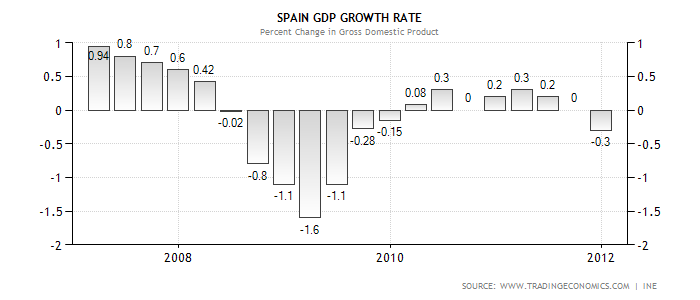So here goes quarterly GDP in Spain for 2010 and 2011:
 A press realease just came out in Italy, saying that (my translation):
A press realease just came out in Italy, saying that (my translation):
“… SEOPAN data indicate a very negative trend in public procurement in Spain. In 2011 they were worth 13,754 bn euro, with a 47,5% decline with respect to 2010, a year in which a decline had already occurred of 33%.
Central administrations had a positive increase of 18,5%, while local and regional public administrations were hit hard by a liquidity crisis, reducing public procurement by 61,4% (the regions) and 68% (local entities). The decline was largest for works in schools, hospitals, sports centers.”
Maybe there is some link between GDP performance and public procurement spending? Just maybe?
See the interesting indirect exchange that occurred between the New York Times correspondant Suzanne Daly regarding waste in local procurement in Spain with Edward Hugh that commented it as follows:
“I started to smell a rat when I saw the example she chose to highlight in her article – the prison at Puig de Les Bases, Figueres (which just happens to be located only a few kilometers from where I live). What worried me is that the prison you can see in the photo above is NOT an example of something that isn’t needed, like a phantom airport, or a golf course where no one will ever play golf. The problem with Puig de Les Bases is not that there aren’t prisoners waiting to be moved there from the two outdated prisons which are scheduled to close (there are, 300 of them, to which can be added an additional 450 once the new one is open). No, the problem here is that there isn’t enough money to run the place after it opens. This situation is not untypical, since many town halls and regional governments, not to mention the central government itself with its new high speed train network that the country can ill afford, find that they invested money on projects using the extraordinary income they were receiving during the years of “excess” but that now they don’t have the current revenue to keep the facilities created operating. In fact Suzanne Daly does notice this, but she seems to get so carried away with the force of her own rhetoric that she doesn’t catch the significance of the point.
“Evidence of the regional profligacy dots the countryside. On the top of a hill here in the birthplace of Salvador Dalí, in northeastern Spain sits a giant, empty penitentiary. But even without a single prisoner in residence, the prison is costing Spain’s heavily indebted regional government of Catalonia $1.3 million a month, largely in interest payments. If prisoners were actually moved in, it would cost an additional $2.6 million a month. So it sits empty, an object of ridicule around here, often referred to as the “spa.” “
So the question is, is this an example of regional profligacy, or an example of cuts which are biting, and a country which is coming to terms with its new reality?”.
So this was a good debate.What matters, when dealing with public spending in a recession is: 1) identify needs, 2) prevent waste, 3) boost the economy.
The austerity-driven speakers instead argue: 1) cut funding, 2) reduce waste and needs, 3) … get the GDP that comes out of it, 4) rejoice in stability, 5) wonder why stability did not come after all.
Which game does Europe want to play?
Thanks to Daniele.
I enjoyed this summer Figueres (not the prison, the Salvador Dalì musem, see picture). I recommend the museum (a bit less the food and the flies, says Chiara).
